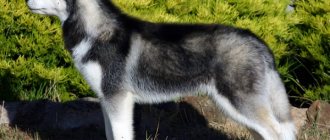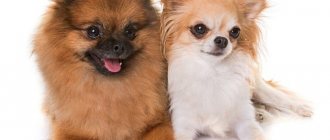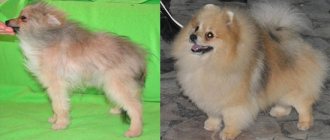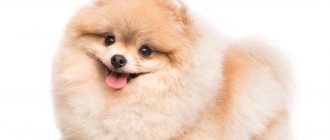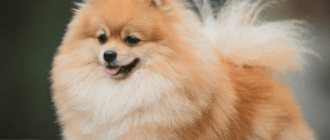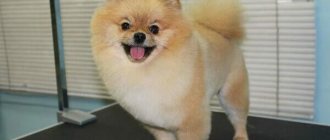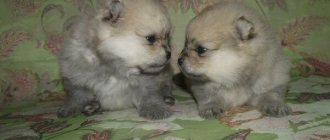| Origin: | Germany |
| Usage: | companion |
| Color: | clear, with tan or spotted, white, orange regular and sable, cream – plain and sable, zoned, brown |
| Dimensions: | 28 cm, 2-4.5 kg |
| Lifespan: | up to 16 years old |
Pomeranian Spitz is a popular decorative breed. Also known as Pomeranian and Miniature Spitz. The dog is a tireless partner for games and walks, a mischievous joker, and a natural artist. His funny fox face and cute antics will brighten up even a stormy day. This is an optimist by nature who will amuse, empathize and support the owner for many years.
Exterior and standard
The Pomeranian Spitz is a controversial breed.
It is recognized by all cynological organizations. But they classify it differently. Thus, the Fédération Cynologique Internationale (FCI) and the Russian Cynological Federation (RKF) do not classify the Pomeranian as a separate breed; they classify it as a dwarf variety of the German Spitz. While the AKC considers the Pomeranian to be a separate species.
There is also confusion with the name. So, Pomeranian or Pomeranian is an Americanism. In the USA this is the official name of the breed. In Russia and European FCI member countries it is called a miniature spitz, a dwarf spitz, sometimes a mini-spitz, and in England the terms royal or Queen Victoria spitz are still used.
The miniature spitz standards of Europe and America are also somewhat different. A bear cub with a blunt muzzle, rich undercoat and rounded ears - this is what the Pomeranian Spitz looks like in the USA. And according to the FCI and RKF standards, the German Spitz is a fox with light bones, abundant guard hair and large ears.
It is not surprising that photos of dwarf Spitz differ in different countries. When choosing a puppy and evaluating a dog, it is worth considering that domestic breeders adhere to the FCI exterior.
General requirements
The Dwarf Pomeranian is the smallest representative of the German Spitz. It differs from the medium and small type only in size, and from the large and Wolfspitz - also in color.
Otherwise, orange is similar to other varieties. This is a strong, compact, agile dog with a fox-like muzzle, a tail curled over the back, abundant undercoat and elegant, erect guard hair.
| Parameter | Breed standard FCI No. 97 |
| Height Weight | up to 28 cm, 2-4 kg. |
| Body type | Strong and dry, without signs of roughness, square format. |
| Frame | The back is short and straight with a convex, short loin and sloping croup. The neck stands high, dry, the withers imperceptibly flows into the top line. The belly is moderately tucked, the chest is voluminous. |
| Head | Proportional, wedge-shaped. The transition from head to muzzle is pronounced. The latter is elegant, light, narrowed. |
| Nose | Black. |
| Ears | Relatively small, triangular, erect, pointed. Stay high and close to each other. |
| Eyes | Medium, oval shaped. Spaced widely, in dark shades with a curious and perky expression. Moderately recessed, not bulging. |
| Lips | Dry, with dark pigmentation. |
| Bite | Scissor-shaped, straight is allowed. |
| Tail | Of medium length, carried high, thrown over the back and pressed tightly against it, rolled into a ring. Abundantly covered with fluffy wool, spreading like a fan. |
| Limbs | Medium length, with lean muscles. They stand straight and parallel, the front ones are under the body, the rear ones are pulled behind the ischial tuberosities. |
| Fingers | Collected into a ball, small, with black claws. |
Coat and color
The Pomeranian's coat is part of the dog's exterior, its pride and decoration. It is very thick, long, stands upright due to the abundant undercoat. The latter is soft in contrast to the hard guard hair.
The distinctive features of the Miniature Spitz are the decorative elements of its coat. So, on the back of the neck and neck it lies like a lion's collar, on the shoulders it forms rich feathers, on the hips - panties, and on the tail it forms a fluffy, abundant fan. At the same time, the muzzle, ears, and lower parts of the paws are covered with short, velvety fur.
There are 10 types of Pomeranian colors:
- black;
- black and tan;
- wolf or zonular - silver with black tips and glasses around the eyes;
- brown;
- redhead;
- orange-sable;
- cream;
- cream sable;
- spotted – brown, orange, gray or black spots are located on a white background;
- white.
A mini-Spitz of solid colors should have a coat of uniform color, without lightened or darkened areas.
Disqualifying faults
The Mini Spitz is removed from the ring for:
- color outside the standard;
- ears with rounded ends, drooping or not fully erect;
- short or elongated format;
- dull muzzle;
- heavy or light frame;
- sunken or bulging eyes;
- hanging tail;
- curly, short guard hair without undercoat;
- undeveloped and undescended testes in males.
Frame
According to the standard, the body of representatives of the Pomeranian Spitz breed should be stocky and round in shape. Well-developed, rounded ribs frame a toned abdomen. The skin, which fits tightly to the body, does not form folds.
The powerful back of short length has the shape of a straight line and is well developed. In order for a Pomeranian to lift its head high, it must have oblique shoulder blades.
The strong, small loin has a slightly convex shape.
The dog's neck is pulled back at the shoulders, continuing the straight line of the back. The fluffy undercoat makes the neck seem very small.
The chest of representatives of this breed should be deep, but at the same time not too voluminous.
The tail is one of the most distinctive features of the Pomeranian. According to the standard, it must be level and high above the back, thereby rounding the dog’s silhouette. The tip of the tail curls.
Males should have two well-developed testicles that are completely located in the scrotum.
Unrecognized varieties of oranges
There are 2 varieties of the breed, whose exterior differs from the requirements of the standard. This:
- Bear species of Pomeranian Spitz. With heavy bones, a rounded head with a flattened muzzle.
- Doll types, also toy or baby dolls. An intermediate option between a regular Pomeranian and a bear cub. The length of the muzzle is longer than that of a bear, but shorter than that of a classic type orange.
Sometimes the bear-type Pomeranian is the result of the skillful hands of a groomer. On the head, the guard hair is simply compared with the undercoat and rounded off. This visually shortens the Miniature Spitz's muzzle and makes the eyes and ears round.
Baby dolls and cubs are the results of improper selection.
Representatives of this type carry the dwarfism gene and have all the disqualifying defects. These Miniature Spitz dogs have sore joints, cardiovascular and digestive systems. In fact, pets are a degeneration of the breed. At the same time, a huge number of breeders register nurseries of doll-type and bear-type Pomeranian Spitz. Their cute appearance has made decorative dogs popular and desirable for thousands of owners.
Proponents of the purity of Miniature Spitz consider the trend to be detrimental to Pomeranians. If the situation continues, it will lead to a decrease in the gene pool of true Spitz, their modification and degeneration.
Head
The head is in proportion to the dog's body. It has a wedge shape, reminiscent of a fox skull.
The dark-colored eyes are medium in size and are not too close, but not too far apart. In a healthy dog they should shine. Monochrome representatives of the breed have blue and brown shades and there is no pigmentation around the eyes. In other cases, there is black pigmentation near the eyes.
The ears are relatively close to each other and small in size. In a Pomeranian, they should always be in a standing position, triangular in shape.
The skull is of medium size and quite wide between the ears. Tapering towards the nose, it has a well-defined transition from the muzzle to the forehead. The rounded forehead is quite voluminous.
If a Pomeranian Spitz has a domed, rounded skull, then, according to the standard, this is a defect.
The dog's non-pointed muzzle is very thin and has a pronounced transition. The length of the skull to the length of the muzzle has a ratio of 1:2. The cheekbones are rounded and should not protrude.
The small, round nose is black in color. The exception is the brown Pomeranian representatives of the breed - their nose is dark brown.
The absence of pigmentation on the lips is acceptable only in Pomeranians of the same color brown and blue colors. In all other cases, there should be black pigmentation near the lips.
A dog's correct set of teeth should consist of forty-two small teeth. This small breed may be missing some premolars.
The bite is a scissor bite, meaning the inner surface of the upper jaw should barely touch the outer surface of the lower jaw. One protruding tooth is not considered a defect by the standard, but if the entire lower jaw protrudes, this is already a defect.
Character
The Zwergspitz is the embodiment of cheerfulness and love. This fluffy does not know despondency, melancholy and sadness. He is always on the move, ready for new games, discoveries, walks, and activities.
The Mini Spitz is naturally fidgety. He disturbs the owners, incites children into mischief, and exhausts other dogs, cats, birds and rodents to death. The Pomeranian never seems to get tired. Even after many hours of walking, a minute or two is enough for him to regain his strength.
The dwarf Spitz is a kind of electric broom. This cutie is like a ray of sunshine. But the character and habits of the orange also contain negative aspects.
Pomeranians are annoying. He becomes attached to his owner, does not leave his side for a second and follows the person everywhere, even to the toilet and shower. The Zwergspitz is like a two-year-old child who cannot be left alone.
Against the background of intolerance to loneliness, Pomeranians develop behavioral problems. Their main manifestation is “gibberish”. Left in an empty apartment, the dogs bark, howl and whine. It doesn’t matter how long the owner is absent, the dogs are able to howl for hours on end.
Excessive barking and anxiety are characteristics of the breed. Pomeranian Spitz vocalize for any reason: a visiting guest, a knock behind the wall, a phone call, steps in the entrance, a passing car, a flying fly - all these are serious reasons for barking in the eyes of a Miniature Spitz.
Because of their bark, Pomeranians are considered watchdogs. But this is a conditional quality. The dog actually warns with its voice about unusual events. But he does this out of fear and anxiety.
The characteristics of the breed also include the Pomeranian's tendency to manipulate. In this, Pomeranians have no equal. They are wonderful actors: they know how to portray hunger, melancholy, fear, and throw hysterics. Miniature Spitz understand how beautiful and charming they are and take advantage of it.
The Mini Spitz lives up to the saying “a small dog is always a puppy.” From birth to old age, dogs are curious, energetic, cheerful and playful. Only in the last years of life do miniature Spitz dogs partially lose their temperament.
Limbs
The German Dwarf Spitz is a popular variety of Spitz. Its history goes back more than one century. It is divided into four subspecies:
- Classical;
- Fox;
- Chow-chow;
- Pomeranian.
The classic Spitz has a well-built body and medium hair. The dog's skull and muzzle meet the standards: the fossa between the muzzle and the skull is small, the proportions of the skull to the muzzle are 4 to 2.
The muzzle occupies one third of the length of the skull. The tail is thrown behind the back.
The Fox breed lives up to its name. Its representatives resemble a fox. The muzzle is slightly pointed, unlike representatives of other breeds. The coat is lush. The length of the muzzle to the skull is 2 to 3.
Fingers and paws are extended. The tail has the shape of a ring. The most common Fox color is red.
The Chow Chow is a compact type of Spitz.
It is distinguished by a slightly blunt muzzle and abundant fur. Its paws are wide and short. The ears are neat and rounded. Chow Chows are often overweight.
The Pomeranian is a common subspecies of Spitz. Pomeranians have increased hairiness. The eyeballs are large and round, resembling beads.
Temperament
The advantages of the Pomeranian include:
- Inquisitive mind;
- Persistent character;
- glibness;
- Playfulness;
- Tendency to train.
Until now, experts cannot agree on whether some of the Spitz’s character traits are hereditary. A dog can be spoiled as a result of improper upbringing and lack of care.
The most unpromising dog from the point of view of heredity and genetics can turn into a good, loving companion.
If a Pomeranian is not raised correctly, it will grow into an annoying, noisy little dog, yapping at passers-by and biting children.
One of the developed Spitz breeds is distinguished by a particularly active and temperamental character, which dog breeders are trying to get rid of.
Owners of dwarf Spitz dogs are advised to keep their dogs away from children. Small children do not know how to properly handle pets; they can tear out their fur or provoke aggression.
Liveliness, playfulness and perky character are considered the most remarkable feature of animals of this breed. The dog needs movement and freedom of movement.
It is important to walk your pet and play with it using special toys. If you devote enough time to the animal, the Pomeranian will quickly grow into an obedient, trained dog.
Mobility
The Spitz breed standard implies that representatives of the breed are characterized by smooth movements and an agile, but not loose, demeanor. The pet must move correctly. The following features of movement and body structure are considered incorrect:
- Turned elbows;
- The hind legs should be placed close to each other;
- The joints should be straight.
Wool color
At exhibitions, Pomeranians are divided into dark and light depending on the shade of their coat. The first are dogs of the following colors:
- Dark chestnut;
- bluish;
- Black.
Breeds of light shades include Pomeranians, whose coat has the following shade:
- Bright red;
- Ruby;
- Redheads;
- Light.
Acceptable colors according to the standard are:
- Monocolor;
- Monotonous color interspersed with a different tone;
- Solid color with splashes of black and sable;
- Sable color;
- Spot;
- Black color with red specks.
Black and tan color refers to black breeds whose eyes, muzzle, part of the chest, throat, limbs and tail may be reddish, brown or rust-colored.
Spotted color means a white breed interspersed with a different tone.
A solid color with white speckles on the chest, muzzle and paws is considered a bad sign.
The pet's color must match its breed.
Disqualifying faults
The Mini Spitz is removed from the ring for:
- color outside the standard;
- ears with rounded ends, drooping or not fully erect;
- short or elongated format;
- dull muzzle;
- heavy or light frame;
- sunken or bulging eyes;
- hanging tail;
- curly, short guard hair without undercoat;
- undeveloped and undescended testes in males.
Socialization
Mini Spitz are natural extroverts. They are friends with everyone: children, dogs, cats. Even parrots and guinea pigs are friends in the eyes of Pomeranians, not prey.
At the same time, the Miniature Spitz will tire of all pets with its obsession. He pulls cats by the tails, pulls out feathers from birds, and takes carrots from rabbits. But he doesn’t do this out of malice: this is how he plays.
The only problem arises between the males. Pomeranians are dominant, consider themselves big dogs, and do not know how to compare their own strength with that of their opponent. They will even get into a fight with a Cane Corso or Alabai. Confrontations end with injuries or death of the little brave men. That’s why they don’t take their eyes off the “Napoleons” while walking.
It is not advisable to bring children under 6 years of age to a house where Pomeranians live. Kids don’t understand how to properly handle animals and can literally squeeze a fragile dog to death.
But for children 8-10 years old, the dog will become a wonderful companion. She loves children and is ready to play with them for hours and run around the street. The only thing is that Miniature Spitz dogs with behavioral problems are not left alone with children. If a psychologically balanced Pomeranian does not offend a child, then an ill-mannered dog may snap or bite the baby.
Pomeranians are wary of strangers. But if strangers do not threaten them or their owner, they are quickly accepted into the “flock.” And if you treat the dogs with a treat and praise them, their hearts will be won.
Dog food
Having such a miniature size and playful character, the Spitz really needs high-calorie food, the percentage of protein in which should be 30-35%. The dog's stomach is small, so the Spitz quickly gets full, and low-calorie food does not provide the necessary energy reserve for high activity.
German Spitz needs high-calorie food
Meat should be present in the dog’s diet every day; it must be slightly boiled and cut into small pieces. Fiber, which is found in vegetables and grains, should make up a smaller part of the diet. The amount of food a dog eats per day is 10% of its weight. So, if the weight is about 5 kg, then 500 g of the finished product (not dry food). For an adult dog, you should offer food twice a day after a walk. Cottage cheese, kefir, whey are an excellent addition to the main diet, but milk can cause diarrhea in the dog.
Upbringing
The mini Pomeranian is smart, quick-witted, remembers commands, and does complex tricks like seeds.
But there are a lot of ill-mannered Pomeranians. What is the reason? The fact is that owners of decorative breeds consider small dogs not dangerous. This means there is no need to deal with them. The result is an unbalanced Miniature Spitz, who feels like he is the head of the family and almost the center of the Universe.
This position is dangerous. The mini-Spitz doesn't look scary. But any dog is a bladed weapon. A bitter orange bite hurts, it can tear muscles and bite through veins. Not to mention the fact that an ill-mannered miniature spitz ruins the nerves of its owners and those around them.
Pomeranian puppies should be taught discipline from the first minutes in their new home. The rules are set once and for all. Up to 4 months, the Pomeranian is simply raised, and then commands from the main training course are introduced.
Training the Miniature Spitz is complicated by its tendency to be stubborn and manipulative. Plus, pets have a delicate, easily excitable nervous system. Therefore, you need to find a balance between hardness and softness, to be an affectionate, loving, but demanding owner who is not forgiving of antics.
The main skills that a miniature Spitz must learn, in addition to OKD, are the ability to remain alone and not bark in vain. Any causeless barking is stopped at the first yelp, and they are gradually accustomed to loneliness, leaving the Miniature Spitz at first for a couple of minutes, gradually increasing the time to several hours.
Diseases of the breed
The most common disease of German Spitz dogs is a predisposition to obesity. If the Spitz cannot fully satisfy its physical activity, then it is necessary to reconsider its diet.
If excess weight appears, then weak ligaments and, as a result, lameness will take the owner by surprise.
Dogs of decorative breeds, which were obtained through artificial selection of the smallest individuals, need constant dental care. Tartar causes discomfort to the dog. It gradually grows on the teeth and over time begins to irritate the mucous membrane of the mouth.
Changing teeth in a puppy also requires control from the owner: the baby teeth may not fall out on their own, and then you need to invite a veterinarian to help.
Features of maintenance and care
A Pomeranian Spitz dog can get along anywhere. She would be suitable for both a one-room apartment and a country house. The only thing is that you can’t place a Miniature Spitz on the street - it’s a decorative dog that needs comfort and communication with people.
In warm weather, the Pomeranian can stay during the day for several hours in a special walking enclosure. But usually the pet cannot stand loneliness; it is more interesting for him to play with a person than to keep himself occupied.
In the house, wires are first removed into cable channels, carpets are raised, shoes and clothes are hidden, fragile objects are moved higher, and cracks and holes are sealed. This way the Pomeranian Spitz puppy will not get hurt, and the owner will protect the property from the pet’s sharp and curious teeth.
Grooming
Caring for a Pomeranian Spitz is simple and easy to do yourself at home. The only procedure that requires the hand of a professional is a haircut. But it is simple: the coat of the Miniature Spitz is simply trimmed, and the owners themselves master this simple skill over time.
Grooming a Pomeranian is aimed only at giving the dog a neat appearance. You cannot cut the guard hair down to the undercoat, affecting the latter and spoiling the natural appearance.
Dwarf Spitz shed moderately, more heavily in spring and autumn. But they have a dense undercoat, thick hair that bunches up in tangles behind the ears, in the groin and between the toes. Cutting them spoils the elegant coat of Pomeranians - dogs with bald spots look ugly in person and in photographs, and they are not allowed to exhibit.
Therefore, Pomeranians are combed daily, maximum every other day. During the molting period, the fur coat is tidied up twice a day.
Otherwise, the Miniature Spitz is unpretentious. Need to:
- examine the mouth for the presence of caries, plaque, inflammation, and bleeding gums;
- brush your teeth 2-3 times a week;
- give hard vegetables and toothpick treats to remove plaque;
- trim nails every 3-4 weeks;
- remove nitrous oxide from the eyes;
- Inspect your ears weekly to remove plaque and wax from them.
Bathing
The Miniature Pomeranian should not be washed frequently. A protective fat layer forms on the dog's fur, which is washed away with frequent bathing. The optimal frequency of the procedure is once a month.
Miniature Spitz dogs are not bathed during shedding. Falling hairs become tangled when wet, and it is impossible to comb the fur coat.
Here's how to bathe a Pomeranian:
- pre-comb, sort out or pluck out tangles;
- plug your ears with cotton wool or sponges to prevent water from getting into them;
- completely wet the wool in the shower;
- Apply zoo shampoo diluted in water to the fur - use special rulers for long-haired dogs;
- beat the shampoo into foam, rinse thoroughly;
- use conditioner or balm if desired;
- Dry with a hairdryer at low temperatures and at the same time comb the fur.
After bathing, it is not advisable to go for a walk or leave the dog in drafts - the miniature Spitz may catch a cold.
Walk
Although the Mini Spitz is a decorative dog, it is not a sofa dog. He is athletic, always going for many hours of walks, games, and activities.
Therefore, they walk the Pomeranian twice a day for 1-2 hours. Immediately after going outside, the miniature spitz is allowed to relieve itself, frolic, communicate with its relatives, and then they move on to training and practicing tricks. They end the walk on a positive note – with a game.
It is not recommended to walk Pomeranians on harnesses or metal chains - they wear out the luxurious coat. The best choice is leather collars.
If your miniature Spitz is trained at home to go to the diaper or go to the toilet, you can skip walking in inclement weather.
Feeding
The dwarf spitz is a picky person. He loves treats, sweets, flour, and often refuses to eat healthy cereals and vegetables. Coupled with manipulative talent, such an attitude towards nutrition will lead to diseases of the gastrointestinal tract, blood vessels, heart, joints, and skin.
It is necessary to form correct eating habits in a Miniature Spitz from puppyhood. The easiest way is to feed your dog with ready-made holistic or super-premium food for miniature breeds. Suitable:
- Piccolo Small Dogs;
- Applaws Puppy Small & Medium;
- Acana Heritage Puppy Small Breed;
- Grandorf Adult Mini;
- Optima Nova Puppy Sensitive All Breeds.
On a natural diet, it is more difficult to balance a Spitz’s diet and calculate the optimal portion size. Plus, the miniature Pomeranian is prone to obesity, food allergies, and deficiencies in feeding are reflected in the coat. Therefore it is imperative:
- give lean cooked meat;
- exclude potential allergens - chicken, corn, wheat;
- vegetables are given stewed or boiled;
- the miniature spitz loves raw sweet fruits, but is not carried away by them;
Additionally, vitamin and mineral supplements are introduced into the orange's diet.
Toilet training a dog
It is not difficult to accustom a puppy to the tray when there is an enclosure. Cover the floor with newspapers; puppies will get used to going to the toilet on a certain surface. Over time, the newspaper can only be placed in the tray, and the puppy will look for a familiar smell. When walking for the first time, you will also have to walk with a newspaper, and only after a year will the pet be able to endure the walk. And you need to take walks three times a day.
Photo of a dog on a walk
I have always dreamed of a small dog. But before getting an animal, I took its choice seriously. After weighing all the pros and cons, I settled on the Spitz breed. The dog is very beautiful! And the eye will always be happy. With proper care, of course. The Spitz's coat consists of a guard and an undercoat, making it look like a plush toy. Scratching once every 2-3 days is enough. Washing frequently is not necessary. Only when dirty and without shampoo. Blow dry! I wash it once every three months. There is no smell. But this also depends on the right choice of shampoo.
Marina
Health
In terms of health, the Miniature Spitz is a controversial breed. On the one hand, he is hardy, active and full of strength into old age. The average life expectancy of a Pomeranian is 14-16 years. On the other hand, the dog is fragile and susceptible to numerous hereditary and acquired pathologies. Among them:
- alopecia;
- black skin syndrome;
- congenital deafness;
- nanism;
- dislocations and subluxations of the knee and elbow joints;
- hypothyroidism;
- defects of the eyeball, retina, iris;
- hydrocephalus.
In addition, the dwarf Spitz often suffers from eczema, dermatitis, allergies, obesity, and disorders of the cardiovascular and digestive systems. Another weak point is teeth and gums. The Miniature Spitz suffers from caries, gingivitis, and complicated replacement of milk units with permanent ones.
Disease Prevention
Some owners believe that because Mini Spitz are decorative dogs; they do not need vaccinations or antiparasitic treatments. However, this opinion is wrong. Even indoor cats that have never gone outside can catch viruses, fleas or worms. Therefore, preventive measures are mandatory. So:
- a Pomeranian Spitz puppy is vaccinated against distemper, parainfluenza, leptospirosis, herpes, and rabies before the age of one year;
- adult Pomeranians are annually given comprehensive vaccinations against possible viral infections;
- Miniature Spitz dogs are treated every month for blood-sucking parasites, and once every 3 months for helminths.
Mating
Those who plan to buy a Pomeranian for breeding should know that mating and childbirth are difficult for the breed.
Before joining the ranks of breeders, learn everything about the breed and breeding characteristics. Difficulties are associated with:
- the size of the Miniature Spitz - often even ideal parents give birth to overly large puppies or with the dwarfism gene;
- hereditary diseases - they move from litter to litter, there are no absolutely “pure” Pomeranians: at least somewhere in the pedigree there will be a relative with a genetic pathology;
- obtaining the desired color - a specific color often has to wait for several litters, gradually deepening or lightening the color;
- directly by childbirth - a dwarf Spitz rarely gives birth on its own; a caesarean section is usually performed.
Plus, in the first years you will have to forget about profit. As a rule, 2-3 Miniature Spitz puppies are born in a litter, with a maximum of 6. And it is not a fact that all of them will be healthy and meet the standard.
Flaws for which dogs are disqualified
- Malocclusion;
- Ectropy or entropy;
- Semi-erect ears;
- White spots on Spitz dogs are not white or spotted.
Common disadvantages:
- Wet eyeballs;
- Light iris color;
- The skin around the mouth should be dark;
- Incorrect motor skills.
Defects are grounds for disqualifying a dog from competitions where the purebred Spitz is assessed. Flaws are a disadvantage when determining his thoroughbred by the jury.
How to choose a Pomeranian
The first and main rule when buying a Miniature Spitz is to forget that there are any varieties of the breed. There is only one correct Pomeranian exterior, and “bear cubs” and “dolls” are commercial products, and painful ones at that.
The remaining recommendations for choosing Pomeranian Spitz puppies are standard:
- first look at photos of puppies and manufacturers, then get to know the breeder and miniature Spitz live;
- evaluate the conditions of keeping Pomeranian Spitz in the nursery;
- examine the Pomeranian puppies - they should be healthy, without pathological discharge from the eyes, nose, anus, lively, curious, playful.
It is impossible to predict exactly what color a particular puppy will have. Babies under one year old molt twice, exchanging their baby coat for an adult coat. Their color and wool quality change.
How much do puppies cost?
Mini Pomeranians are expensive. Even for breeding without documents they ask for 10-15 thousand rubles.
The price for purebred Miniature Spitz is off the charts. So, pet-class babies who do not participate in exhibitions and breeding will cost at least 30,000 rubles. Breed-class cuties cost from 50 thousand in rubles. And for future champions they ask for 80-100 thousand rubles and more.
Nurseries
You can buy a Pomeranian Spitz puppy, see photos of litters and parents, and get acquainted with the pedigrees and titles of the producers in the following nurseries in Moscow:
- https://minipes.ru - “Minipes”;
- https://spitz-kennel.com – “Heaven Heart”;
- https://spitzflying.ru - “Flying Spitz”.
In St. Petersburg, the following nurseries are engaged in professional Spitz breeding:
- https://bestilrean.spb.ru – “Best Ilrean”;
- https://www.tswergspitz.rf - “From the cloud over the Neva.”
All of these nurseries are registered with the RKF and the National Breed Club, comply with the rules of these organizations, and breed Miniature Spitz dogs that meet the standard.
The Pomeranian Spitz is a popular decorative dog. However, the demand for it is not good for the breed: unscrupulous breeders often dump sick puppies and adjust the exterior of the Miniature Spitz to the demands of fashion and the desires of buyers. To get a healthy, purebred dog, you will have to memorize the standard and choose a kennel that works according to the rules of the Russian Canine Federation.

